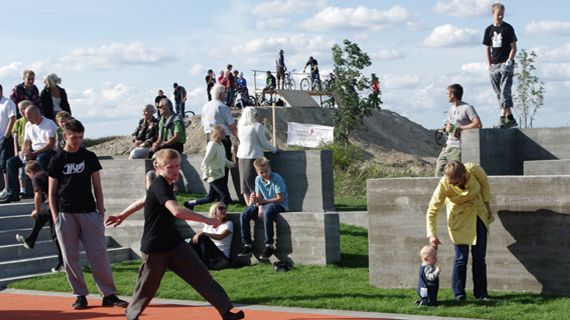a+t Strategy Public: Landscape Urbanism Strategies
Published Wednesday, January 26, 2011.
Strategy Public: Landscape Urbanism Strategies is a new book from a+t architecture publishers.
STRATEGY PUBLIC opens a new series in a+t’s architectural catalogue. Although it follows a visual and diagrammatic style similar to their previous publication, the noteworthy urban landscape analysis guide titled THE PUBLIC CHANCE, this latest book is more focused on the subject of project design strategies – the fine balance between architectural manifestations and the primary set of objectives that guide their creation.

Kragh & Berglund, Plug’N’Play, Ørestad South, Copenhagen, Denmark, 2008.
It’s an unusual approach considering other forms of conventional theoretical research. The finished project is often the critical starting point in the search for meaning. Here we are confronted with an alternate investigation method: an attempt to scrutinize the strategies that precede the design process. To understand the methodologies through which concepts are put into practice. STRATEGY PUBLIC offers an outlook into different planes of intervention: economic, social, environmental, formal. It starts by inquiring project objectives, from the seminal programmatic considerations to the concepts through which these are translated into form. Additionally, external factors are taken into consideration – such as the specificities of the site, the ecological concerns, the target users, the financial constraints of the operation – and the ways these become determinant to the development of the project.

Mutopia, City Park, Ørestad, Copenhagen, Denmark, 2005-2008.
More than 20 built works of urban design and landscape architecture are represented and each one of them is analysed regarding these particular strategies and their subsequent conceptual outcome. This is definitely a+t’s most detailed book to date, containing meticulous technical drawings and informative diagrams that dissect every single project. Some address the need to reinterpret existing landscapes, to adapt surfaces, introduce new materials and explore inventive lighting solutions. Others are focused on the need to connect and activate interstitial spaces, to introduce new functions and themes or deal with sensitive issues such as rainwater and plantation management. These may range from ambitious, large scale operations, to projects that deal with more prosaic considerations such as spending cuts or the need to reuse pre-existing materials and structures. The careful selection and diversity of examples is ultimately what makes STRATEGY PUBLIC such an outstanding learning tool and a unique design resource manual, a book that every urban designer and landscape architect should definitely take into consideration.


Kristine Jensens, Nicolai Cultural Centre Courtyard, Kolding, Denmark, 2007.


Kragh & Berglund, Plug’N’Play, Ørestad South, Copenhagen, Denmark, 2008.


Michel Desvigne, Seguin Island Gardens, Paris, France, 2010.


Mutopia, City Park, Ørestad, Copenhagen, Denmark, 2005-2008.


Arteks, Perruquet Beach Park, Vila-Seca, Spain, 2009.
ENGLISH EDITION
The English-only edition of the blog A Barriga de um Arquitecto is no longer being updated. Please visit the main page to access new content, additional information and links.
ARCHIVES | ARQUIVO
September 2008 October 2008 November 2008 December 2008 January 2009 February 2009 March 2009 April 2009 May 2009 June 2009 July 2009 August 2009 September 2009 October 2009 November 2009 December 2009 January 2010 February 2010 March 2010 April 2010 May 2010 June 2010 July 2010 August 2010 November 2010 January 2011 February 2011 March 2011 June 2011 July 2011 October 2011 December 2011
